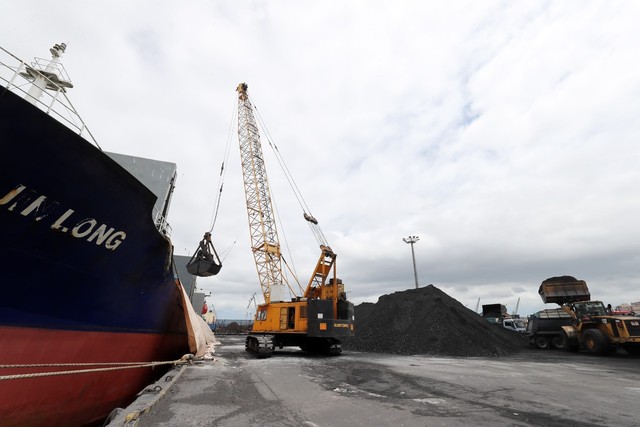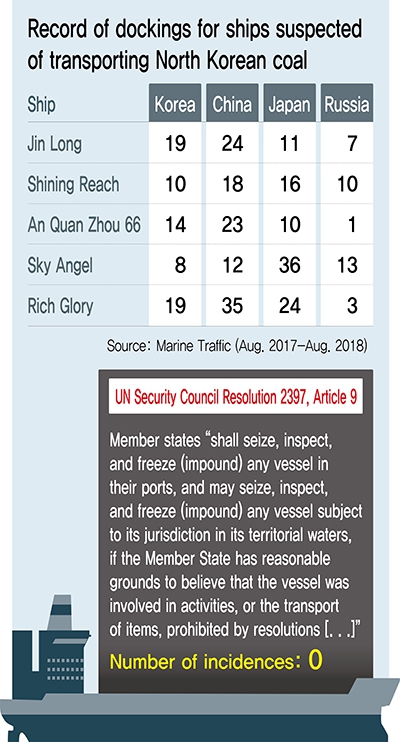 |
|
A crane unloads coal from the ship Jin Long docked at Pohang New Port, Pier 7, in North Gyeongsang Province, on Aug. 7. Despite assertions from conservatives and the press that the coal is North Korean in origin, the Ministry of Foreign Affairs has declared that the vessel was carrying Russian coal and therefore did not violate any sanctions. (Yonhap News)
|
Conservatives criticize government for failing to implement UN sanctions
Ships suspected of carrying coal from North Korea are a topic of fierce debate. The Liberty Korea Party (LKP) and the conservative press are treating the importation of North Korean coal as an established fact and criticizing the government for failing to impound the ships in question. The tenor of this criticism is that the government is not properly implementing UN Security Council sanctions against North Korea that ban the import and export of North Korean coal. Behind this criticism is the political insinuation that the government was aware of the coal’s origin but swept it under the rug to prop up improving inter-Korean relations.
This overlooks the fact that Japan, despite its hardline stance against the North, has never impounded the ships either. The government is currently investigating nine cases of suspected imports of North Korean coal. It’s planning to take action if it acquires “reasonable grounds,” such as confirmation that the coal originated in the North.
The Hankyoreh has taken a closer look at how the ongoing debate over the coal imports came to be and the facts that have been confirmed so far.
Beginning of the controversy
 |
|
Record of dockings for ships suspected of transporting North Korean coal
|
The controversy was set off on July 17 by a report published way back in March by a panel of experts with the UN Security Council Sanctions Committee on North Korea. The whole thing can be summarized as follows. 1) Between July and September of last year, ships from the North Korean ports of Wonsan and Chongjin unloaded coal at the Russian port of Kholmsk; 2) ships called the Sky Angel and Rich Glory loaded coal at the port of Kholmsk and transported it to South Korea; 3) therefore, the coal is presumed to be North Korean in origin. The report stated that, “if confirmed,” this might be in violation of UN Security Council resolutions. So this is not a confirmed fact, but speculation that remains to be confirmed.
When the controversy arose, the government stated that it had been working on an investigation based on intelligence it had received from its allies in Oct. 2017 – before the report was published – that 9,000 tons of coal “presumed” to come from North Korea had been shipped to South Korea by way of Russia.
LKP raises additional allegations
On Aug. 5, LKP lawmaker Rep. Yu Gi-jun further alleged that five ships flying under foreign flags – Shining Rich, Jin Long and An Quan Zhou 66, as well as Rich Glory and Sky Angel – had unloaded what is believed to be coal from North Korea. Yu alleged that the Jin Long, a ship registered in Belize that docked at Pohang on Aug. 4, was one of the ships suspected of importing coal and that it had unloaded 5,100 tons of what was assumed to be coal on this stop.
Yu didn’t provide any evidence to support his claims, however. When reporters asked on Aug. 7 for proof that this was North Korean coal, he said, “Since this has also been reported by other newspapers and by the foreign press, you shouldn’t need my explanation to figure it out.”
“The Jin Long was loaded with Russian coal, and when the relevant agency inspected the ship, they did not confirm allegations that it was violating the UN Security Council resolution,” said an official from South Korea’s Ministry of Foreign Affairs.
Why is Japan silent, when it’s on the front line of sanctions against the North?
UN Security Council Resolution No. 2371 bans the import and export of North Korean coal, and Resolution No. 2397 states that “Member States shall seize, inspect, and freeze (impound) any vessel in their ports [. . .] if the Member State has reasonable grounds to believe that the vessel was involved in activities, or the transport of items, prohibited by resolutions.”
According to Marine Traffic, a website that provides information about vessel locations, the two ships mentioned in the panel report visited a number of South Korean ports, including Busan and Pyeongtaek, multiple times in Oct. 2017, with Sky Angel making five calls and Rich Glory making 16. This is the grounds the LKP and the conservative press have been using to bash the government for deliberately failing to stop these ships.
But what they failed to mention is that even the Japanese government under Prime Minister Shinzo Abe, which has taken a very hardline stance toward North Korea, has not impounded the ships in question, either. From Aug. 2017, when the UN Security Council banned the import and export of North Korean coal, until now, the ships that are the subject of the allegations raised by Yu Gi-jun have made dozens of stops to ports not only in South Korea but also Japan, China and Russia. Sky Angel and Rich Glory, both of which are mentioned by the panel report, entered Japanese ports 36 and 24 times, respectively, during that same timeframe, but they were not impounded even once.
“Japan has not taken any measures about the ships mentioned in the panel report. Japan’s view is that there isn’t enough evidence [to impound them or take other measures],” said an official with the South Korean Foreign Ministry.
There’s a reason that it’s not easy for various governments to impound suspicious ships based on UN Security Council resolutions. These governments have the responsibility to prove their case, including the question of intentionality.
“It’s the responsibility of our government to prove the charges if it’s going to issue some kind of ‘punishment’ such as impounding a ship in accordance with UN Security Council resolutions. Objective proof is needed before a ship can be impounded or seized,” said Kim Gwang-gil, an attorney.
“The most important thing is to establish that the coal comes from North Korea. Another thing to consider is intentionality – whether the ship’s crew was aware they were transporting coal from North Korea,” a government official said. Furthermore, the ships in question have never been placed under sanctions by the UN Security Council Sanctions Committee on North Korea.
Can North Korean coal be identified?
It’s difficult to identify coal’s place of origin based on its components alone, as the South Korean Foreign Ministry explained in a document issued on Aug. 8: “The results of a component analysis by themselves are not enough to confirm the place of origin. Investigators are taking a wide range of actions – including reviewing documents and conducting raids – to confirm [the coal suspected of originating in North Korea]. [Coal’s] components and calorific value and moisture content can indicate whether it is bituminous coal or anthracite coal, but the analytical results can differ even with coal from the same mine or production site.”
Previously, the South Korean government impounded Talent Ace (formerly called the Xin Sheng Hai), when it entered the port of Gunsan at the beginning of the year. Authorities determined that Talent Ace had transported coal from the North Korean port of Nampo to the Chinese port of Bayuquan and the Vietnamese port of Kampa in July and August 2017. Seoul is planning to take the appropriate legal action if the investigation into the nine incidents turns up proof that the coal comes from North Korea.
By Kim Ji-eun and Noh Ji-won, staff reporters
Please direct comments or questions to [english@hani.co.kr]










